  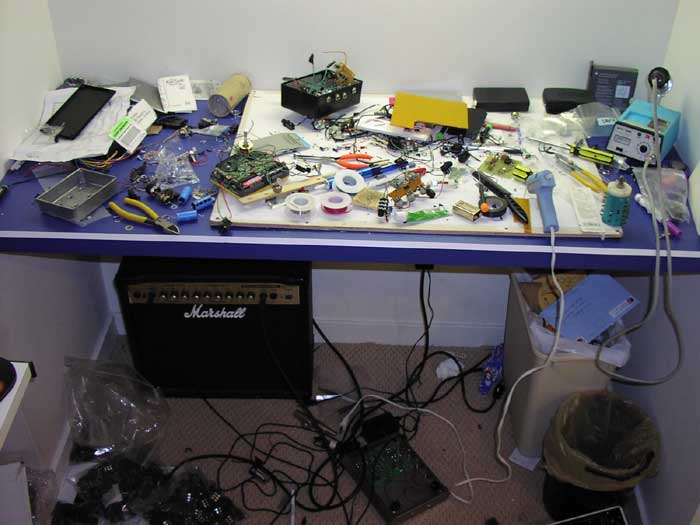 Note the 2 extra jacks on the top-this was a send and return for integrating other noisemakers into the circuit. The third picture is of my very very messy workstation around the time when I had made it (see it back in the back there?) There was no feedback loop or anything in this, it was simply an odd self-oscillating beast. The 10 knobs consisted of power saggers, gain knobs, volume knobs, send/return knobs... I know that there were no tone knobs at all. Here is a picture of a single PU circuit on a very crappy and early breadboard I was using:  As I slowly pulled myself together to get ready to sell these, I tweaked the circuit here and there until it became something quite different than the original version... although the designs are similar and the pedal itself has the same genera purpose (oscillating fuzz), each version was very different. At that point, there was really only one pedal to compare it to, the Fuzz Factory, and at one point I felt so much like I had stumbled on the Fuzz Factory's circuit that I posted a thread in the HC forums asking Zach if it was OK for me to continue on. He gratiously agreed. Here is a picture of the refined version on a different and much better breadboard: 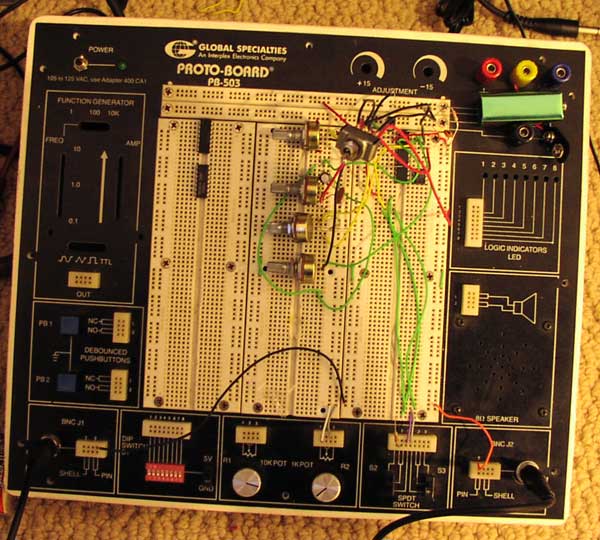 After more tweaking, I got around to putting into a sensible enclosure for various people to try out. This was in very late November 2003. The prototype was unbelievably ugly. 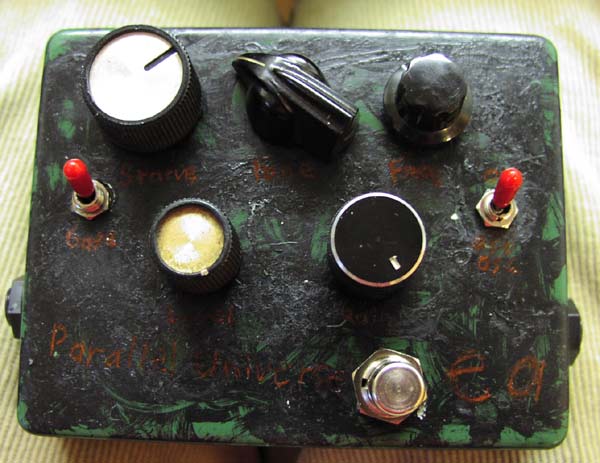 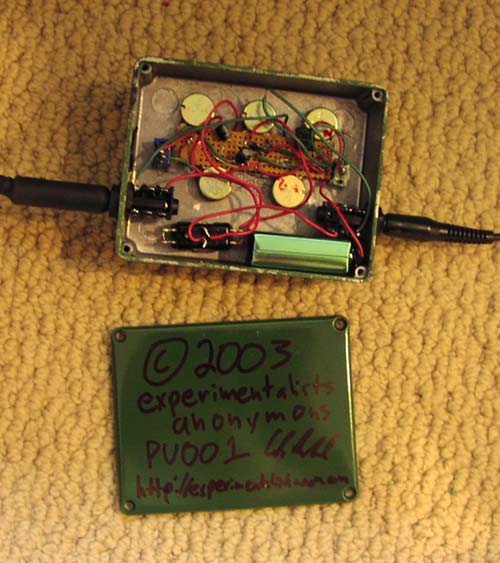 I ended up going over the knob lables with a silver sharpie to make it easier to read. It found itself in many people's hands, and I found myself tweaking again. This prototype is currently in the hands of Mike Tykowski. Speaking of Mike, this is where he makes an entrance to the story... Shortly after making the prototype I announced that I was finally able to sell them at $150 a pop, completely handmade (on perfboard, probably). Not too long after, Mike Tykowski, a harmony central regular, contacted me by e-mail to ask if I wanted to collaborate with him on this Parallel Universe thing and the rest of my more professional DIY ventures. Since I had been greatly fearing the dull construction process and since Mike sounded like a good guy, I agreed, and thus began the long planning of what was to become the current line of Parallel Universes. The first matter at hand was to design the tops of the enclosures (as well as decide on parts, boxes, prices... which is actually a VERY VERY long and tough process): 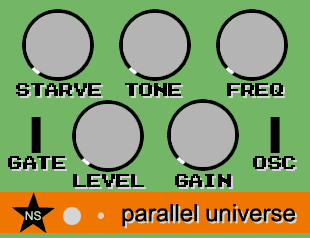 This was probably the first main design that was made for it. This was basically modelled after the prototype. The NS star on it stands for North Star effects, which is what Mike and I called our venture together. 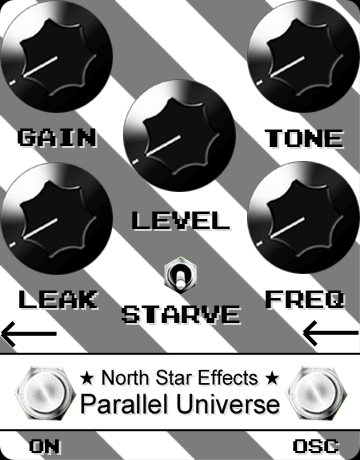 Here's one of the odder ones once we were getting closer to the current design. Instead of doing stickers as I ended up doing, this was a possibility in case we were going to do silkscreening.  Here is basically what we finally came up with. The main difference is the NS star instead of the EA letters, as well as the removal of the input/output arrows (the current PU has them on the top). So, we ordered parts, PCBs (which actually ended up taking months and months.. first Futurlec messed up our order so we gave up on them, then we had someone else do it in a more handmade style which took a bit longer), and all of the packaging and made ready to build Parallel Universes. I think neither of us were ready for the amount of pure production work this was-soldering parts on PCBs is no day at the fair. After a month or so, however, I got around to finishing them. The process looked something like this: 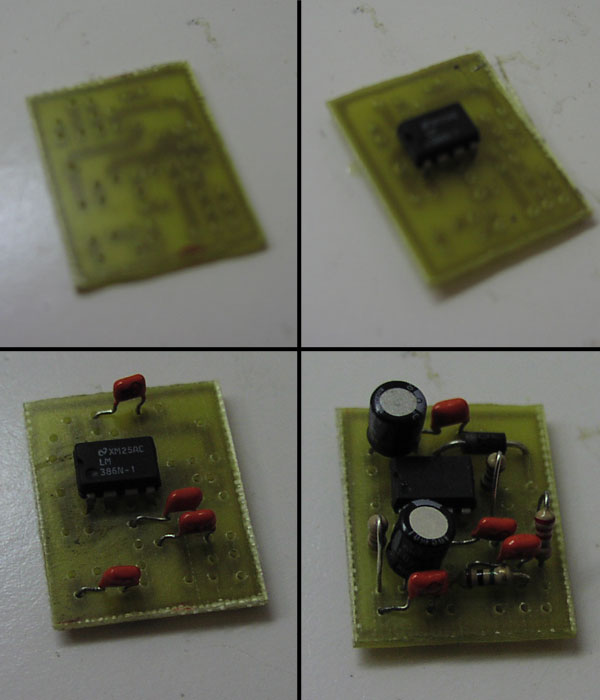 Then, they were off to Mike to finish constructing them. Here is a little drawing I made up for Mike, just to try to show how to wire them up since the only example he had was the outdated prototype:  At this point, Mike got super busy and basically after a long wait I just said "you know, we should get these done, why don't you just send them back here", which led to the eventual end of North Star Effects in its entirety. Mike is a great guy and good to work with, he really helped focus the ideas that went into this, and I don't regret or resent the time lapse that was caused at all. So, with PUs in hand, I was faced with the labor which led me to pursue the relationship with Mike in the first place. While I was in California over the summer, I met Jake Rebol, who showed me the innards of one of his pedals. It was quite well made, so I figured, why not ask him to make these for a price just like Mike was going to do? He gratiously agreed, and the parts for the PUs went off to him to be made. He ended up getting them done quite fast, using a single PU I wired up as an example (you can see this one as a sort of naked version in the following pics... this was sold at a discount to my longtime friend who positively gushed over the pedal and who was in a pinch for cash). Here are a ton of misc pictures I had him take while he was making them (thanks jake for putting up with my constant requests for pics): 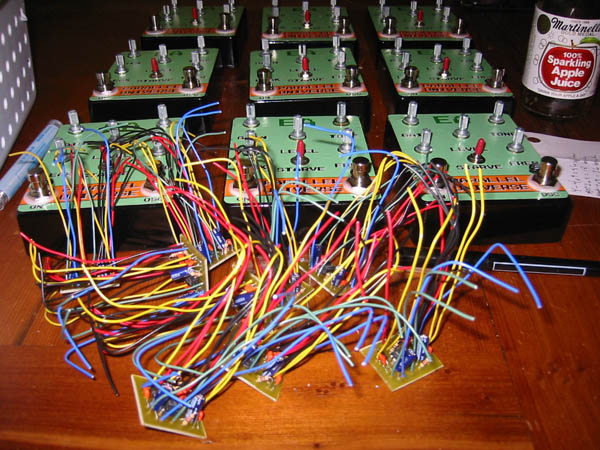 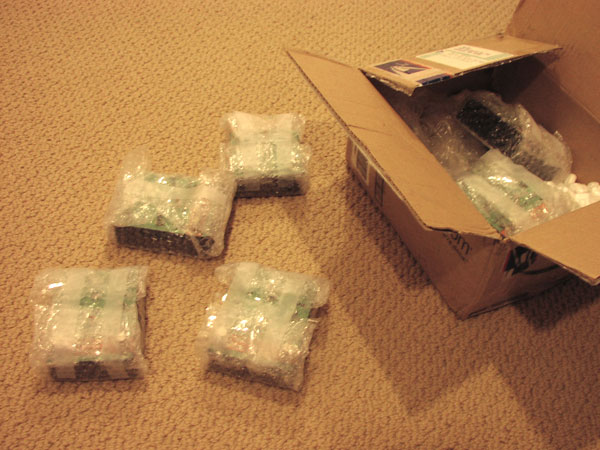 The PUs were finally available. After some fixing up, boxing up, and testing, they are finally available for sale... and a very limited number, at that. This will probably be the last time I do this sort of production work in a while-it's very time consuming even to just figure out manuals and serial numbers and all of that, and I give my greatest compliments to the pedalbuilders of the world who put up with this on a day to day basis. |